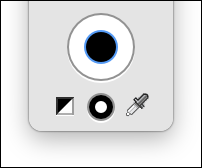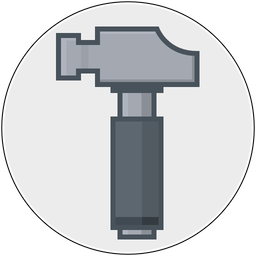Hello fine people of the Internet. Good day to you.
I'm currently putting the finishing touches on the next version of Acorn, v5.2, and I'd like to invite you to try it out. You can download Acorn 5.2b1 from the latest builds page.
There's two notable changes that I'd like to call out. The first is the color well in the tools palette. It has a simple new look, which I think clears up quite a bit of confusion that people have had in the past when trying to figure out which color was used for stroke, and which was for the fill.

I think it's pretty obvious now which color is going to be used for fill, and which color is stroke. In addition, the fill and stroke checkboxes in the inspector now have little color wells you can click on to quickly change the color of your selected shapes.
The second new feature, and my personal favorite and one that I've been wanting for years, is deep color support for the 2015 iMac 5k as well as to the Late 2013 Mac Pros.
I'll get to the technical bits in a minute, but the short version is this: no more banding, more colors, and a wider range of accuracy and values for your filters to play with.
Since it's creation, OS X has been sending 24 bits of color (aka "True Color", or 16.7 million colors) to our displays. Even if you bought a fancy display which was capable of showing more colors, you would only see 24 bits because the graphics plumbing just wasn't in place to push more color.
However, with OS X 10.11.1, that changed. And we even have some hardware to show it off.
The displays in the iMac 5k (the most recent, as well as the previous generation) are capable of receiving 30bit "deep color" when running on 10.11.1 and later. The late 2013 Mac Pros are also candidates for this if they have a decent monitor hooked up.
So how many colors can Acorn 5.2 push to the display now?
Over one Billion
1,073,741,824 to be exact.
That's kind of amazing.
What does that mean in practice? Color banding is a thing of the past. Dithering when using the gradient tool in Acorn is no longer happening. You also have a wider range of values to manipulate when adjusting exposure or temperature or other color controls. You can actually see all the colors when taking photos with your 14 bit RAW cameras now.
It's great, and it's the future, and I love it.
So what do you need for this? Obviously, you'll need the Acorn 5.2 preview, and a 5k iMac or a Mac Pro with a 30 bit display.
If you just want to view images with deep color, you can do so with Acorn 5.2 and OS X 10.11.1.
If you want to use Acorn 5.2 to adjust or make new deep color images, you'll need to be running the latest OS X 10.11.2 public beta. It contains some fixes that are needed for Acorn to work correctly when handling deep color images.
And finally, if you're creating new images with deep color support, you're going to want to create your images with 16 bpc (bits per component or channel)*. This does mean that your file sizes will be bigger (more color data equals bigger files), but in my opinion it's worth the tradeoff.
And as always, if you run into any issues, questions, or ideas, let us know by emailing support@flyingmeat.com.
* Technically a 16 bpc image is capable of having 281,474,976,710,656 different colors, but we don't have display technology available to show them all. Images like this are still pretty useful for certain scientific applications though.
** It's really hard to show off screenshots of what deep color looks like in practice since web browsers are only showing 8bpc images. So here's a crappy photo of Acorn 5.2 (on the left) and Photoshop (right) displaying a 16bpc image. This is of course is a 8bpc image, but it shows the compressed range of PS vs Acorn anyway.
*** You can download that test Acorn image from here: purple_green_gradient_16bpc.png, or use the native Acorn version with the live gradient filter from here: purple_green_gradient_16bpc.acorn. Try switching the latter image between 16 and 8 bpc to see the banding come and go.
